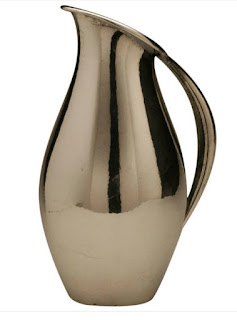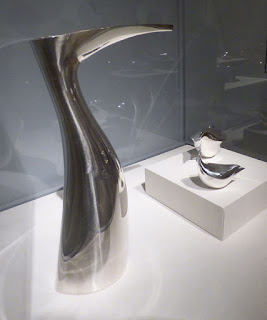Georg Jensen - Scandinavian Design at the Art Institute of Chicago
Gerhard Henning (1880-1967)
There was no Danish figure sculpture in this Summer's exhibition of Scandinavian design at the Art Institute of Chicago. (as the above might suggest, there are many fine examples from which to choose.)
But one might note that the silversmith, Georg Jensen, and several of his collaborators, were initially trained in figurative sculpture.
Regretfully, I walked right past the entrance to this exhibit many times on my way to the John Singer Sargent exhibition across the hall.
Georg Jensen (1866-1935), 1912
Georg Jensen (1866-1935), 1915
His importance to cultural history might have ended there - except that he turned out to have a talent for business as well as design and craftsmanship. He began hiring other silversmiths and designers - and eventually had to open a line of credit to meet the demands of the large orders he was receiving. Then, as tastes changed, he had to adapt to his larger, international market - changing his own style and recruiting up-to-date talent. Not surprisingly, eventually he became estranged from the management of the multi-national corporation he had built, and returned to running just one of the many shops within his commercial empire.
Georg Jensen, 1929
The beaker shown above seems much closer to art deco than to the
Arts and Crafts movement reflected in Jensen's earlier work,
like the serving dish to the right
Arts and Crafts movement reflected in Jensen's earlier work,
like the serving dish to the right
Georg Jensen, 1925
Here's a drawing made for the candelabra shown above it. It seems to guide, rather than tightly control, the craftsman who would cut, hammer, and assemble it out of sheets of silver.
Here's the process is demonstrated by Allan Scharff, the only living designer whose work appeared in this show.
****************
Johan Rohde (1856-1935), Pitcher 432C, 1920
Judging this design to be too radical for its time, Jensen waited five years
before he began to produce and sell it.
Rohde was Jensen's first major collaborator. They met when Rohde invited Jensen to participate in an arts and crafts exhibition (Den Frie) that he had organized. He then commissioned Jensen to execute some of his designs.
Johan Rohde, self portrait
Like Jensen, Rohde had gone to school for fine art --- but unlike Jensen, Rohde came from a wealthy family and was able to build a career in painting as well as design for silverware.
He is quoted as advocating a "Combat over-elaboration" to "bring forth a pure, simple style"
Rohde's acorn flatware, first produced in 1915, has been quite popular
Many pieces are still in production today
This is his drawing for the pitcher shown above. It's poor condition may be the result of having been tacked on the wall above a work bench for several decades.
****************
Harald Nielsen (1892-1977)
Nielsen was the brother of Jensen's third wife. He started working for the company in 1909 as a chasers apprentice,and then rose through the ranks to eventually become artistic director.
He is best known for his "pyramid" motif,
made popular by the discovery of King Tut's tomb in 1922
This is his popular pyramid flatware
Here is a preliminary sketch for the game dish shown above it.
Rather than being a guide for the silversmith, it appears to be study
that includes various alternate details.
pyramid coffee service
pyramid condiment tray
*****************
Oscar Gundlach-Pedersen (1887-1970)
Also trained in figure sculpture, Pedersen became Georg Jensen's last apprentice in 1911 - and eventually became assistant director of the silversmithery.
**************
Sigvard Bernadotte (1907-2002)
A Swedish prince who was recruited right out of art school, he would go on to co-found Bernadotte and Bjorn in 1949 - the first Scandinavian studio devoted entirely to industrial design.
Coffee and tea service, 1952
ice water pitcher, 1952
******************
Henning Koppel (1918-1981), 1946
Koppel was a Swedish illustrator and jewelry designer who was working in Stockholm when Anders Hostrup-Pedersen recruited him in 1945. The story goes that he accepted employment by Georg Jensen on the condition that he be allowed absolute autonomy.
1952
Fish dish, 1956
Eel dish, 1956
My favorite piece in the show -- and apparently the favorite of many collectors as well.
One of them recently sold at auction for over $100,000
candelabrum, 1958
melamine, 1965
(how thoroughly sixties)
sauceboat, 1967
toast rack,1970
(no breakfast table can be without one)
tureen, 1978
candelabra
caravel flatware, 1957
1951-52
1952
1952
Salt and Pepper, 1949
*****************
Jorgen Jensen (1895-1966), Cannister, 1936
Jorgen Jensen
Herbert Krenchel, (1922-2014)
Krenit bowls (steel and enamel), 1953,
Torben Orkov and Co.
The bowls were formed from millimeter-thin sheet metal and coated on the outside with sandblasted black fiber cement (asbestos-free Eternit); Inside, an enamel layer is applied in bold colors
*********************
Magnus Stephensen (1903-1984), 1954
stainless steel
1958
Ice bucket,1951
(MOMA --- not in this show)
covered serving dish, 1957 (MOMA --- not in this show)
1952
***************
Piet Hein,(1909-1966), Super Egg
This hollow ellipical box applies the geometric formula of the "super elipse" developed by Piet Hein
who was a scientist and poet as well as designer.
***************
Soren Georg Jensen (1917-1982), stackable tea pot, 1950
Another son who apprenticed into the silversmithery and went to art school.
He became the company's artistic director in 1962 and spent his final years as an abstract sculptor.
The pieces shown below are stainless steel.
1959
1963
1963
***************
Svend Siune (b. 1935), Blue Shark steel flatware
Siune is also a graphic artist - but it looks like the above flatware, designed early in his career, has been his claim to fame.
******************
Verner Panton (1926-1998), 1987
Panton was already a celebrity designer
when he began designing for Georg Jensen.
Crash Plate, 1988
A tribute to the American ABX sculptor, John Chamberlain
An architect by training, Panton also designed unique interiors
He is best known for the Panton Chair,
designed in 1963 and first produced in 1968
Looks like a scene from "Austin Powers - the Spy who Shagged Me"
My father loved this kind of chair.
and I grew up sitting on quite a few.
The color and shape of the seat was the same,
but they rested on a frame
of black iron rod legs.
******************
Vivianna Torun Bulow-Hube (1927-2004),
chandelier 1980-1990
Torun, famous for her jewelry, was
another celebrity designer hired to jazz up the offerings.
various designs of her flatware are still under production
************
************
************
Sivert Thorsteinsson, 1759
By way of comparison to the 20th Century Scandinavian silver in this show --- consider this lively piece made in Copenhagen in the 18th Century. It looks like it's quite capable of walking - or even flying - right of the coffee table.
Here's a Danish spoon from the 17th century that's no more ornate than something Jenson might have produced -- but it certainly feels different. Is 'classical' the right word?
Tyge Madsen Werum, 1736
This piece is not as wild as the Thorsteinsson piece above -- but it also feels more vegetative than pieces from the 20th Century.
Tyge Madsen Werum, 1737
This piece could be early 20th Century - except for the detailed medallion.
What's especially wonderful about silver is it's mirror-like surface. So comparisons made from photo reproductions are problematic. The camera cannot capture the way some of these vessels seem to float in space.
It does seem that 20th century Danish is not radically different from what came before. It does seem to emphasize, however, the personal and aspirational rather than the natural or the social.
Also new, and perhaps irreversibly different, is the industrialization of production.
Georg Jensen was trained as both a sculptor and silversmith. By the middle of the twentieth century, the leading designers had never touched hammer and torch. They were pioneers in the field of industrial design.
One exception would be Allan Scharff who apprenticed as a silversmith at the age of 18 -- and ended up making silver hollowware worthy of Brancusi.
Allan Scharff (b. 1945), Ibis pitcher
with Flycatcher and Snipe bonbonierres, 1990
Allan Scharff, Mars Base Dish, 1995
Not to say that this piece does not belong on a dining table --
but its functionality as a serving dish is debatable
Sadly, the company that currently owns the name of Georg Jensen is mostly producing designs by artists who passed away decades ago,
There may well be some exciting new designs being transformed into silver -- but finding them presents quite a challenge.
Possibly, the Georg Jensen Company has marked the end, rather than the beginning, of a great tradition of silversmithing.






































































































0 Comments:
Post a Comment
<< Home